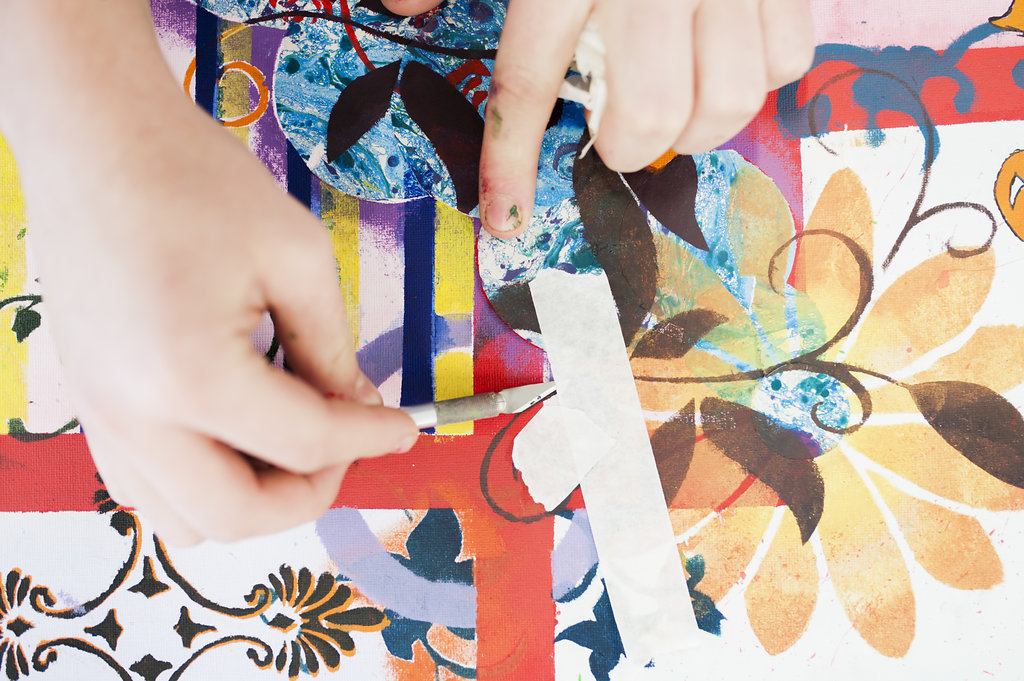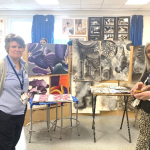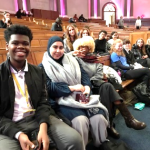Students will learn to analyse in a supportive and respectful manner the visual art works of others; recognise visual arts as a continually evolving entity that incorporates many different media; create pieces of art work that portray emotions and personality; learn the skills to apply the arts to all areas of their academic, personal and professional lives and develop a growing appreciation of the role of the artist, works of art and development of the arts in the community.
Art and Design

It is our vision in the Art and Design department to nurture and explore the artist within all students. While doing so, students will develop their understanding of basic concepts of design and elements of art; be enhanced intellectually by the history and style of the visual arts; celebrate and respect works of art from global cultures; create artwork that integrates emerging technologies as well as traditional techniques.
It is our vision in the Art and Design department to nurture and explore the artist within all students. While doing so, students will develop their understanding of basic concepts of design and elements of art; be enhanced intellectually by the history and style of the visual arts; celebrate and respect works of art from global cultures; create artwork that integrates emerging technologies as well as traditional techniques.
In Year 7 students begin by developing basic tonal skills in a variety of wet and dry media which they then use to create their own still-life paintings. They then move on to a ‘Right to Write’ project that explores Vincent Van Gogh’s Self Portrait of 1889. Students then produce their own self portrait from what they have learnt in their essays.
Year 8 students begin with a project that explores the mythical “Green Man” character which ends with an A2 oil-pastel study. They also produce a Right to Write essay within this project that looks at the work of Arcimboldo’s surrealistic nature portraits. Students then move on to a Landscapes project that investigates the use of mixed media and expressive painting.
In Year 9 students begin with a project looking at the human figure which culminates in a 2D response looking at the work of the Futurists, and a 3D sculpture after looking at the reclining figures of Henry Moore and the stick-like figures of Alberto Giacometti. Students then finish Key Stage 3 with a project looking at typography which they then interpret as either an acrylic painting or a 3D letter. Students will then complete their ‘Right to Write’ essay on the impact of Constructivist design and typography on Bolshevik ideology.
Course description:
This course is a natural extension of KS3, focusing on Fine Art and Graphic Design.
The course will: Improve existing practical skills and offer opportunities to learn new ones.
- Students will increase their Art History/artist knowledge and appreciation, and how to have it make a positive impact on their work.
- They will refine their ability to tell when something looks ‘right’
- They will develop an insight into aesthetics, as well as knowledge about composition and design.
They will learn the skills, techniques and processes to develop ideas into visual form and by being informed of the diverse and exciting world of Art and how to look and use other artists work in idea development. Finally, they will be encouraged to develop an educated opinion and appreciation of Art forms and what is around them.
Students study GCSE Unendorsed Art and Design that consists of two broad units: Natural Forms and Landscapes. Students are encouraged to follow independent lines of enquiry with teaching staff at hand to guide and advise.
Students are currently entered for their GCSE through AQA examination board. Students must submit a portfolio that reflects 45 hours of supervised work undertaken in the classroom. This accounts for 60% of their overall grade. The remaining 40% of the grade is a 10 hour terminal exam that the students prepare for over an eight week period.
AS Photography
Students follow an endorsed AQA AS level course for one year on Photography. There is a 15 hour practical examination at the end of the year that is internally marked and then externally moderated. This 15 hour timed-piece would be the culmination of around two to three months of image research and preparation beforehand.
In their first weeks students explore a series of skills based workshops around technical photography, including aperture and shutter speed, light measurement, lighting equipment and darkroom techniques. These skills are essential to be able to execute ideas for a thematic project afterwards. Idea progression and exploration, research of varied artists and visits to shows and galleries will help students create their own informed response, which will be evidenced in the form of a sketchbook. The final piece can take on a multitude of shapes like prints on different canvasses or digital animations.
Students are expected to repeat their study time at school independently and produce 5 hours of work per week outside lessons. It is preferential for students to own their own camera equipment.
What is AS-Level Photography all about?
This 1 year course explores a vast range of essential skills in photography such as understanding camera settings on a digital SLR camera, darkroom wet film photography, studio lighting, how to analyse the work of photographers, developing your own ideas and exploring creative and experimental techniques. Students will present their work creatively in sketchbooks.
Students will be required to visit photography exhibitions and galleries as part of homework followed up with a written review. Independent skills are of great importance as much of your homework will be to plan and set up your own photo shoots and taking photos on a weekly basis.
What can I expect at AS level Photography?
· Engaging lessons with a focus on practical tasks and understanding
· Work on practical assignments, which will ask you to take images out of school hours in most weeks
· Support from experienced Photography staff
· Practical work supported with research relating to visual languages used, i.e. ‘how images communicate’
What will the course look like?
· AS level photography comprises of 60% portfolio work, which is evidence of technical knowledge and planning and execution of different projects.
· You will study the workings of a digital SLR camera, use Photoshop to edit your images, create film-based images and photograms in the darkroom, use a sketchbook to record and develop your ideas
· Students will study contemporary and historical photographers to help them understand how photography has evolved over the years.
· Students will be able to choose their own specific field in photography to develop, like Portraiture or Still Life
· Students will be able to use studio equipment to take images in school, but will also be required to take most of their shots in their own time outside of lesson time
· Students will critically discuss their ideas and projects in small groups and assist each other when required.
What will be studied?
Unit Content: choice of 1 or more from the below Assessment Weight
AS
Component 1
Portfolio · portraiture · landscape photography (working from the urban, rural and/or coastal environment) · still life photography (working from objects or from the natural world) · documentary photography, photojournalism · fashion photography · experimental imagery · multimedia · photographic installation · moving image (video, film, animation). Coursework: sketchbook including written research and image portfolio 60%
AS
Component 2
Externally set
assignment Practical exam 15hr 3days 40%
After my studies?
Photography is a challenging A-Level. It requires students to investigate, experiment, evaluate and respond to a series of practical projects. You will be proficient in the skill of using photographic equipment and composing visually satisfying images and will be able to respond to professional briefs in a variety of creative fields using the research skills acquired during the course.
Some common careers for Photography students:
- Advertising
- Graphic Design
- Animation
- Illustration
- Journalism
- Portrait Photography
- Documentary Photography
- Editorial Photography for Fashion, Music etc.
Extra-Curricular Activities
Clubs are offered outside of lessons to support learning beyond the classroom. They are offered to both Key Stage 3 and Key Stage 4 students who wish to expand their experiences further. They are run after-school.
At the core of our approach to marking at JRCS is task marking.
In non-practical subjects one substantial piece of work will be task marked at least once every eight hours of teaching. Students will respond to the tasks and they will be checked by staff. In between that time students’ work may be peer or self-assessed or briefly checked by staff.
It is likely the same piece of work will be assessed for literacy. Staff will mark work using the literacy marking code:
| Sp | spelling mistake |
| P | punctuation mark missing or incorrectly used |
| Voc | incorrect use of vocabulary |
| ^ | word missed out of sentence |
| ~ | unclear meaning or grammar within a sentence |
| // | new paragraph required |
| CL | capital letter error |
Levelling and Assessment
KS3
To develop a growth mindset and reflect ‘life after levels’ work in KS3 books will not usually be levelled; assessment will be formative and highlight how students can improve. Students will record areas of strength and development on their ‘reflection sheets’ which will be at the front or back of the book. At the end of each term a level is reported for students in each subject, which reflects all their work over that term. These are found on students’ pale yellow progress cards, which are stuck into their planners. These cards show students whether they are in line to meet their end of key stage target. With the move away from National Curriculum levels, the school is trialling a new ‘skills thermometer’ and 1 to 9 levelling in English. Other KS3 subjects will be using NC levels for the remainder of this year.
KS4
KS4 practice exam questions and mock exams are likely to be graded. This work might not be in student books. Students will record grades and areas of strength and development in their ‘reflection sheets’ which will be at the front or back of the book. All students receive an attainment and predicted grade at the end of each term. These are found on their pale yellow progress cards, which are stuck into their planners. These cards show students whether they are in line to meet their end of key stage target.
KS5
At KS5 students take a series of VIMAs (Sixth Form Milestone Assessments) during their course. Students receive developmental comments to help them improve their work. Each VIMA result includes four parts: the grade for that assessment, a comparison of the grade with their expected progress grade (EPG), a Learning Capability mark and a prediction of their end of year grade (PEG). The outcomes of these assessments and other graded work will be in student folders. They are also sent home to parents. A summary of VIMA marks and the students’ expected progress grade is also recorded in their planner.
Further Information
All drawing should aim to fill the page unless specifically asked not to. Students should always clearly label any sketches of artwork with the name of the artist, name of work and date created. All work is to be mounted by students from Year 8 onwards prior to assessment. Students should use a folder to transport work to and from home (folders can be purchased through the art department or students can provide their own if they wish). Students should annotate ideas that are not clear visually.
Staff from Art
Claydon, P
Art Technician
Franz, C
Teacher of Art
Hassan, M
Head of Art
Levene, M
Teacher of Art/DT
If you have any queries or concerns, please do not hesitate to contact the school office on 020 8270 6222 or contact the Head of Art, Mr M Hassan at MHassan@jorichardson.org.uk




